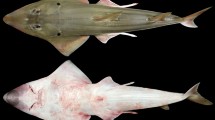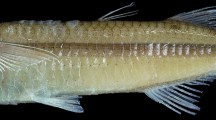Abstract
Two new species of ricefishes or buntingi, Adrianichthys roseni and Oryzias nebulosus, are described from Lake Poso, Sulawesi Tengah, Indonesia, bringing to 12 the number of endemic ricefishes known from Sulawesi. Adrianichthys roseni and its sole congener, A. kruyti, are distinguished from other relatively large-bodied ricefishes, Xenopoecilus, in having orbits that project beyond the dorsal profile of the head; paired preethmoid cartilages (versus single or absent in Xenopoecilus); and 13–16 (versus 8–13) dorsal fin rays. Also, as in A. kruyti, the lower jaw of A. roseni is enclosed in the upper jaw when the mouth is closed; however, the upper jaw is not as large and broadly expanded as in A. kruyti. Adrianichthys roseni differs further from A. kruyti in having fewer scales in a lateral series (approximately 63–65 versus 70–75), attaining a smaller maximum recorded standard length (90 mm versus 109 mm), and having the lateral process of the pelvic bone in line with the fifth, rather than the eighth, pleural rib. Oryzias nebulosus shares with O. nigrimas, also from Lake Poso, a unique sexual dichromatism in preserved specimens: adult males are dark gray to black, whereas females are a lighter grayish-yellow to brown. Relative to O. nigrimas, O. nebulosus is a small species (maximum recorded SL 33 mm versus 51 mm), with pelvic fins relatively anterior (lateral process of pelvic bone is in line with the third, fourth, or fifth, modally fourth, rather than the fourth or fifth, modally fifth, pleural rib), dorsal fin relatively anterior (origin above the 12–14th anal fin ray as opposed to the 15–17th anal fin ray), precaudal vertebrae 11–13, modally 12 (versus 13–14, modally 13), and relatively straight, narrow and slender (as opposed to curved, broad, and robust) ossified and cartilaginous portions of the gill arches. Endemic buntingi are threatened by introduction of exotic species, overfishing, and pollution. A conservation plan includes rearing native fishes for local use as ornamental fishes and possible reintroduction.
Similar content being viewed by others
Author information
Authors and Affiliations
Corresponding author
About this article
Cite this article
Parenti, L., Soeroto, B. Adrianichthys roseni and Oryzias nebulosus, two new ricefishes (Atherinomorpha: Beloniformes: Adrianichthyidae) from Lake Poso, Sulawesi, Indonesia. Ichthyol Res 51, 10–19 (2004). https://doi.org/10.1007/s10228-003-0187-1
Received:
Revised:
Accepted:
Issue Date:
DOI: https://doi.org/10.1007/s10228-003-0187-1




